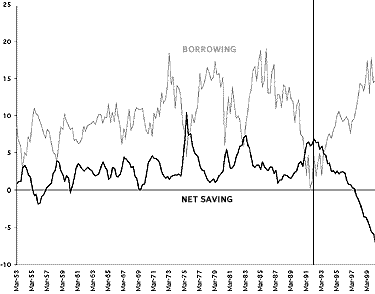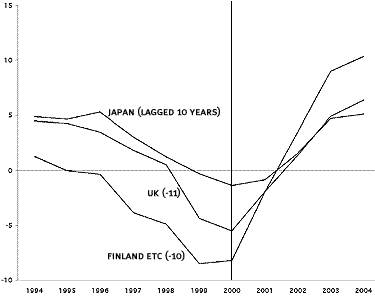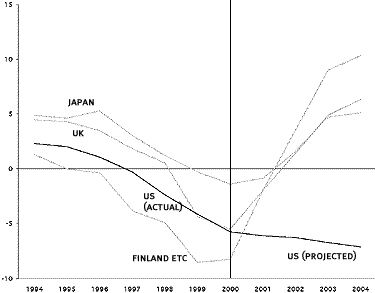The United States is widely believed to have acquired a New Economy, having achieved the longest economic expansion in its history and the lowest unemployment rate for thirty years. Untold wealth has been created, productivity growth has accelerated and inflation has been dormant.
It is generally agreed that the growth of the US economy must soon slow down – or be slowed down by Chairman Alan Greenspan – because unemployment cannot fall much further without inflation waking up. The question of the moment is whether growth will slow down to a rate which just accords with that of productive capacity, in which case there could be ‘a soft landing’. Most people seem to think that if this happens the good times can continue for ever. I doubt, however, that the expansion can continue at all during the next few years without major changes in the stance and structure of policy.
Although the US expansion has been unusually long, it has not been unusually fast. Growth since 1991 has averaged 3.7 per cent per annum, which is only 0.2 per cent faster than the average during the whole postwar period. There have been many nine-year periods during which growth was much faster. It is the growth of private expenditure, taking consumption and investment together, which has been unusually high, with an average growth rate of 4.6 per cent per annum.
How could private expenditure rise so much faster than total output, given that it accounts, by itself, for 85 per cent of all the expenditure which makes up the GDP? How was a quart extracted from a pint pot?
In an arithmetical sense the answer is simple. Private expenditure grew faster than total domestic output mainly because there was a large deterioration in the balance of payments. The pint pot was supplemented by imports of goods and services, which rose at an average rate of 10.4 per cent per annum. Imports have risen, that is, nearly two-and-a-half-fold since 1991.
However, the deterioration in the balance of payments and a growing budget surplus were both factors tending to drive private disposable income downwards. So how was the private sector able to increase its spending so fast? An answer is suggested by the figures in Chart 1, where the black line shows ‘net private saving’ – the gap between private disposable income and private expenditure. For a great many years income consistently exceeded expenditure, as one would expect; net saving fluctuated quite narrowly, averaging nearly 3 per cent of income. Since 1992 expenditure has risen continuously relative to income. Net saving fell through the zero line in 1997 and has been falling more and more deeply into negative territory ever since. In the first quarter of this year net saving reached – 6.9 per cent of income, 9-10 per cent below what used to be normal. Whatever this private deficit may portend for the future, it is certainly entirely different from anything that has ever happened before – at least in the US.
The general view seems to be that private expenditure has risen because capital gains are being spent; so everything should be all right so long as the stock market holds up. But it is impossible literally to ‘spend’ capital gains. Either liquid balances must be run down or securities must be realised (i.e. sold to another sector since selling within a sector only shifts money from one pocket to another) – or additional funds must be borrowed.
Figures published by the Federal Reserve (illustrated by the grey line in Chart 1) reveal that borrowing was the main source of the funds needed to finance excess spending. Borrowing makes it possible to enjoy capital gains without selling shares and thereby incurring a liability for capital gains tax – and the interest payable on loans is often tax-deductible. The private sector as a whole has not been realising equities on a substantial scale. Households have been selling equities, but these were largely mopped up by corporate purchases. And corporations could only buy equities and simultaneously pay for investment in capital equipment by borrowing more themselves. According to the Fed’s figures, the net flow of credit (advances less repayments) to the non-financial private sector taken as whole rose from a negligible quantity in 1991 to more than a trillion dollars in 1999 – by which time (as Chart 1 shows) borrowing was augmenting disposable income by about 15 per cent.
As the flow of lending to the private sector (taking households and businesses together) has been so large, the level of debt has risen in a spectacular way, reaching a record 165 per cent of private disposable income in the first quarter of 2000. Household debt (even if ‘margin debt’ used to finance speculation on the stock exchange is excluded) reached nearly 100 per cent of personal disposable income, an all-time high. And corporate debt reached 74 per cent of corporate GDP – another record, slightly above the previous peak at the turn of 1989-90, just before the last credit crunch.
It seems fair to conclude, at a minimum, that the high level of debt now poses a risk; if there were a big fall in asset prices or a significant further rise in interest rates, weak positions might be exposed which could generate a downward spiral of forced selling. More important, the private deficit, in combination with the Government’s fiscal plans, makes it highly doubtful whether the future can be anything at all like the past. The danger of severe and prolonged recession is being seriously underestimated. In its April report, the Congressional Budget Office (CBO) published projections of the Federal Budget through the next ten years, all based on the assumption that growth will be maintained at about 2.7 per cent per annum, a rate slightly below that of productive capacity, implying that unemployment will rise to just over 5 per cent. All these official projections show the Budget surplus continuing to rise throughout the next decade. The message is that the Government intends to go on tightening its fiscal stance indefinitely.
At the same time, the US balance of payments deficit looks set to worsen if the economy continues to expand while the dollar remains strong. There has for many years been a trend deterioration in the balance of trade which has been exacerbated, perhaps temporarily, by slow growth in the rest of the world. However, even if the balance of trade were now to stabilise as the rest of the world recovers, the foreign debt which the US is incurring is likely to generate a growing outflow of interest income large enough to make the balance of payments as a whole go on deteriorating.
With a deteriorating balance of payments, a rise in the budget surplus can only occur, as a matter of accounting logic, if private expenditure continues to rise relative to income. Total private income from production of goods and services plus property income from abroad (Y) is by definition equal to private expenditure (PX) plus government expenditure (G) plus the current balance of payments (BP). Deduct taxes and transfers (T) from both sides and rearrange to obtain the identity [Y – T – PX] = [G – T] + BP. This formula states that private net saving, the expression on the left-hand side, is logically equivalent to the government deficit plus the balance of payments surplus. It is impossible to over-emphasise the fact that the entire fiscal plan which the authorities have set out, since it combines a rising budget surplus with continued economic growth, can only form part of a coherent macroeconomic strategy on the assumption that private net saving continues to fall into increasingly negative territory. If saving does not continue to fall – if private expenditure rises less than income in the years to come – this must (by the laws of accounting) be accompanied by some combination of a deteriorating budget and an improving balance of payments. And this could only happen (given fiscal stance and trade propensities) if aggregate demand and output were to stagnate or collapse. Without a continued stimulus from private expenditure in excess of income growth, there would be nothing to keep the expansion going. It is theoretically possible, if hardly credible, that a fall in the dollar could result in a rise in net exports large enough to keep US expansion going, as happened in Britain after 1992 – after two years of recession.
Why, you may wonder, should private net saving not go on falling, thereby validating the official scenario? Why shouldn’t the future, for an indefinite period, be a ‘calmed down’ continuation of the past? While the US has never before (at least not in modern times) had a large private financial deficit, there have occasionally been such deficits in other countries. The IMF’s most recent World Economic Outlook points to three instances, illustrated in Chart 2, of private deficits which occurred in, respectively, Japan, the UK and Scandinavia. In each of these cases, having reached a negative position not very different from that in which the US now finds itself, these deficits eventually recovered over a period of years and regained their habitual state of surplus. Sometimes they overshot, so that for a time the surplus was unusually high. In each case the period when the private deficit was growing was accompanied by a boom loudly acclaimed, at least in the UK, as an economic miracle. But each boom was followed by a severe recession as the credit expansion unravelled.
In Chart 3, the path of the US private deficit has been superimposed on those of the countries shown in Chart 2. The black line shows the actual path of the US private deficit up to the first quarter of 2000; thereafter it shows what must be held to happen to validate the CBO’s projection. It seems doubtful, to put it mildly, whether things can turn out this way. As I have argued, the private deficit can only go on rising for as long as net lending remains at least at its present level, so that private debt continues to rise rapidly relative to income. I reckon that to validate the story illustrated in the chart, private debt would have to rise to 230 per cent of disposable income in five years’ time – and continue to rise further thereafter.
An increase in private debt relative to income can go on for a long time, but it cannot go on for ever. It is true that the net worth of households rose from about 500 per cent to more than 600 per cent of disposable income in 1999 alone, and some people have argued that this must completely outweigh any adverse effect from household debt which has been inching up to a mere 100 per cent of income. However, the decisive constraint on borrowing may come, not from the extent to which net worth is being mortgaged, but from the extent to which payments of interest and repayments of principal (which must be settled in cash) can be met out of conventional income. It is income rather than net worth which is ultimately the criterion of creditworthiness, since in a crisis it may be impossible for everyone to realise assets simultaneously. Second, the argument that the net worth of households has risen a lot does not affect the fact that corporate borrowing must have a limit: companies’ debt has been rising rapidly in relation to their income during the last two and a half years.
If private net saving were to recover over the next few years to the level which is normal in other countries, and which was normal in the US until fairly recently, the results would be horrendous. With private expenditure falling by 5-10 per cent relative to income, there would hardly be any growth at all for some years, and if the unravelling took place as quickly as it did in the UK, there would be a severe recession with grave consequences for the rest of the world. The budget surplus would disappear. And it is easy to imagine, with a recession or even a prolonged stagnation, that there would be a large fall in the stock market, which would make matters infinitely worse.
The authorities could reorientate policy so as to avoid the whole scenario I have just outlined. Any fall in private spending could, at least in theory, be offset by an increase in government spending or a cut in tax rates, which might have to take place even though the budget was already moving back into deficit. It is difficult to see how the growing external deficit can be stemmed, as it eventually must, without there being, at some stage, a substantial fall in the dollar. It is to be hoped that contingency planning along these lines is in hand, even though at the moment it runs slap contrary to conventional thinking.
While I believe continued prosperity in the US to be at grave risk without a major change in fiscal and exchange rate policy, I would be a fool if I tried to put a date on the turning point.
Send Letters To:
The Editor
London Review of Books,
28 Little Russell Street
London, WC1A 2HN
letters@lrb.co.uk
Please include name, address, and a telephone number.




